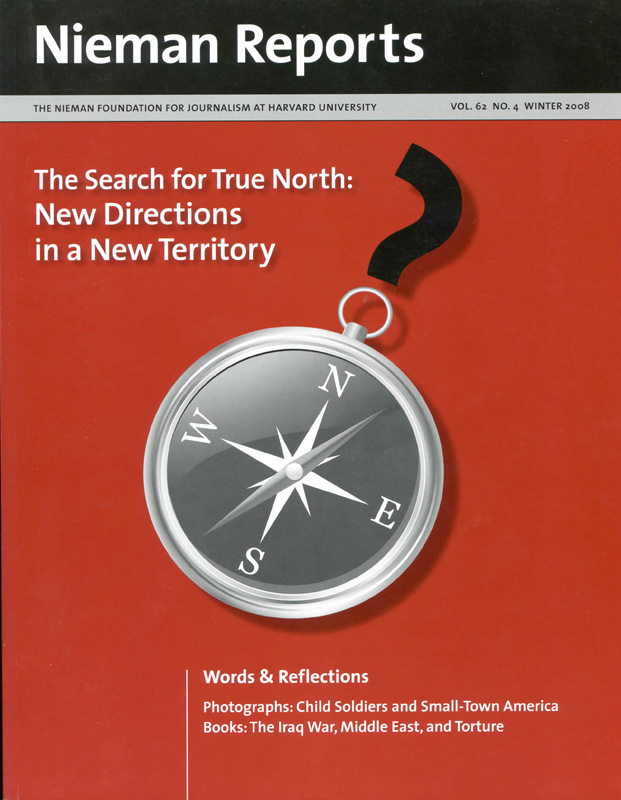
Excuse me for a moment while I get this off my chest—I told you so.
For about two years now, I have been telling friends and colleagues that The Christian Science Monitor was going to dump its Monday to Friday print edition, shift the bulk of its daily reporting and analysis onto its Web site, csmonitor.com, and create a Sunday print edition. And I said it would happen near the paper’s 100th anniversary in November 2008.
I only wish I was this good with lottery tickets.
Now that new Monitor editor John Yemma has confirmed this scenario will become a reality next April, I say bravo! It’s a great idea and continues the Monitor’s pioneering tradition of breaking ground for online media. (The Monitor was the first news Web site to include audio, and it was also the first news organization to send a reporter to cover the Iraq War specifically for a Web site.)
While many fans of traditional models of publishing have bemoaned this decision, it is absolutely the right direction for the Monitor to head in. This decision is one that many other news organizations will make, too, in the next few years. Someone of the Monitor’s stature just had to jump off the cliff first.
History Is Prologue
Before talking about why this move makes so much sense for the Monitor, let me share a bit of history. In 1995 I designed and helped build the Monitor’s original Web site (along with colleagues Ellen Berrigan and Dave Creagh). In those early days, the idea of a Web site for the Monitor was not exactly popular in the newsroom. The organization had just gone through a painful experiment with television that almost killed the paper. When I began to design the site, for instance, I was not given a desk anywhere near where actual journalism took place. Instead, I was placed about as far away from the newsroom as possible—in a small office in the circulation department on the far side of the old Monitor publishing building. I wasn’t really discouraged from talking to journalists about the idea, but I wasn’t exactly encouraged, either.
In those early days, I often felt our survival was a week-to-week proposition. It was only the determined support of David Cook, then the Monitor’s editor and a strong believer in the future of the Internet, which kept us alive. (Dave is now the Monitor’s Washington editor.) More than once, he would call me into his office so that we could discuss ways to make the Web site “bullet proof.” He often called the Web site the Monitor’s “lifeboat.”
There were people in the newsroom in those days who would have pulled the plug on us in a heartbeat. Many saw the $1.5 million it cost then to run the site as just another drain on resources—funds for another printing plant or several more reporters. At one point, the board of directors was receiving information that there were too many of us for the task at hand, and we needed to be cut back. So the board came over one day and watched us as we did our job. By the time they left, after seeing how much work was involved, they were saying that we needed an increase in funding.
There were two key moments in the history of the Monitor that led to greater acceptance of the Web site: the introduction of the Internet into the newsroom and the aftermath of 9/11.
Once reporters and editors had a high-speed connection on their desktops, and they saw what other news organizations like The New York Times and The Washington Post were doing, our Web site made a lot more sense. As for 9/11, you have to understand that the Monitor is a newspaper that is delivered by snail mail. (I can recite from memory even now the angry e-mails I would receive from subscribers who would get three Monitors all on the same day and each several days late.) In the week after 9/11, when all planes in the United States were grounded, the print product couldn’t reach subscribers. The Web site became the Monitor. I saw a lot of light bulbs go on in the newsroom after that. After 9/11, there was never any real talk again of doing away with csmonitor.com.
This brings us to today and why this decision makes so much sense. It’s not a new idea. Former csmonitor.com managing editor Karla Vallance and I would often close the door to her office to talk about the future of the Web site. Even 10 years ago, it was obvious that the Monitor’s future was online. And I believe that even a decade ago, the people at the top of the Monitor knew the same thing but, as Dave Cook once said to me, “No one wants to be the last editor of the ‘newspaper.’”
But the reality of the Monitor’s publishing model worked against the print product. Every time the Monitor got a subscription to the paper, it cost them money. The paper, as I noted above, was delivered by mail—not a really great distribution method in an age of instant news and faster analysis. While the Monitor always stayed away from breaking news because of this situation, those late-arriving newspapers only underlined the fact that the Monitor’s readers weren’t getting the news in a timely fashion. But the real problem was the audience. I remember we were once given a talk about the average age of a Monitor subscriber. It was over 65. At the same time, they found that the average age of a visitor to the Web site was about 45.
Future Is on the Web
One method of distribution obviously had more room for growth than the other.
Now I know that some people are saying to themselves, “Well, the Monitor is a special situation, not like other papers.” And this is true to a degree. The Monitor receives funding from the Christian Science church that helps make up the difference in what the paper lacks in ad revenue and circulation.
But I noticed that when Yemma was talking about the shift last month, he noted that the Web site now generates more ad revenue than the newspaper. That’s a pretty important fact of the Monitor’s life. And while the cost savings of no more crushed ink on dead trees, trucks, gas, etc., won’t entirely cover the cost of lost subscription fees, it will come close. And don’t forget that Sunday print edition. More than a few surveys have shown that Sunday is the day when people have the most time to sit down and read a paper—about an hour and a half, if I remember correctly. It makes sense for the Monitor to take its style of thoughtful, analytical journalism to a Sunday audience. I very much agree with Yemma that advertisers will also find this a more attractive advertising model.
The Monitor’s decision to shift to a focus on the Web during the week, with a Sunday print edition, is going to make a lot of sense to a lot of publishers. Monday to Friday always produces the best numbers for the Web. This makes sense when you think of people’s lifestyles. The Web is a much smarter choice during the week when you have a job and a family, and the opportunities to sit and read a newspaper are limited. (With four kids in our house, I haven’t had a newspaper subscription for several years. I read all my news online. A couple of months ago, my wife decided to get a subscription to the regional paper for our son, who she thought might need it for his civics class. But he uses a special Web site created by his teacher to find stories. Meanwhile, the papers often sit unopened until I get a chance to take them out to the recycling bin each Friday. The one day I do read our family’s new paper subscription—Sunday.)
And none of this accounts for an even more important shift in how news is consumed. For that, we need to look at the lifestyle of young people who increasing rely on mobile devices for information and communication. At one time I thought that as they grew up they would move towards print. But that’s not the case. Statistics show that each of the past four generations has relied less and less on print. And that change was happening even before the Internet accelerated it.
If large news organizations are going to publish a newspaper, I predict they will move towards the model developed by many metro newspapers—a smaller tabloid that is given away for free. It’s the one way that publishers can maintain the high circulation numbers that will interest advertisers.
What I love most about the Monitor’s decision is the courage behind it. I’m not a Christian Scientist, but I am a fan of Mary Baker Eddy, the founder of the paper. She once said that she always wanted the Monitor to “keep abreast of the times.” Those few words have inspired generations of Monitor editors, reporters—and Web producers—to not take the safe way. This is not easy when publishers, to invoke Robert Frost for a moment, come to two paths that diverge in the woods. But taking the one less traveled does make all the difference. And I suspect that the Monitor will not find itself alone on that less traveled path for very long.
Tom Regan, a 1992 Nieman Fellow, works for the Online News Association, where he was its executive director and now assists his successor in a variety of tasks. He has also been the news/politics blogger for NPR and worked in various editorial positions for csmonitor.com for 12 years.



